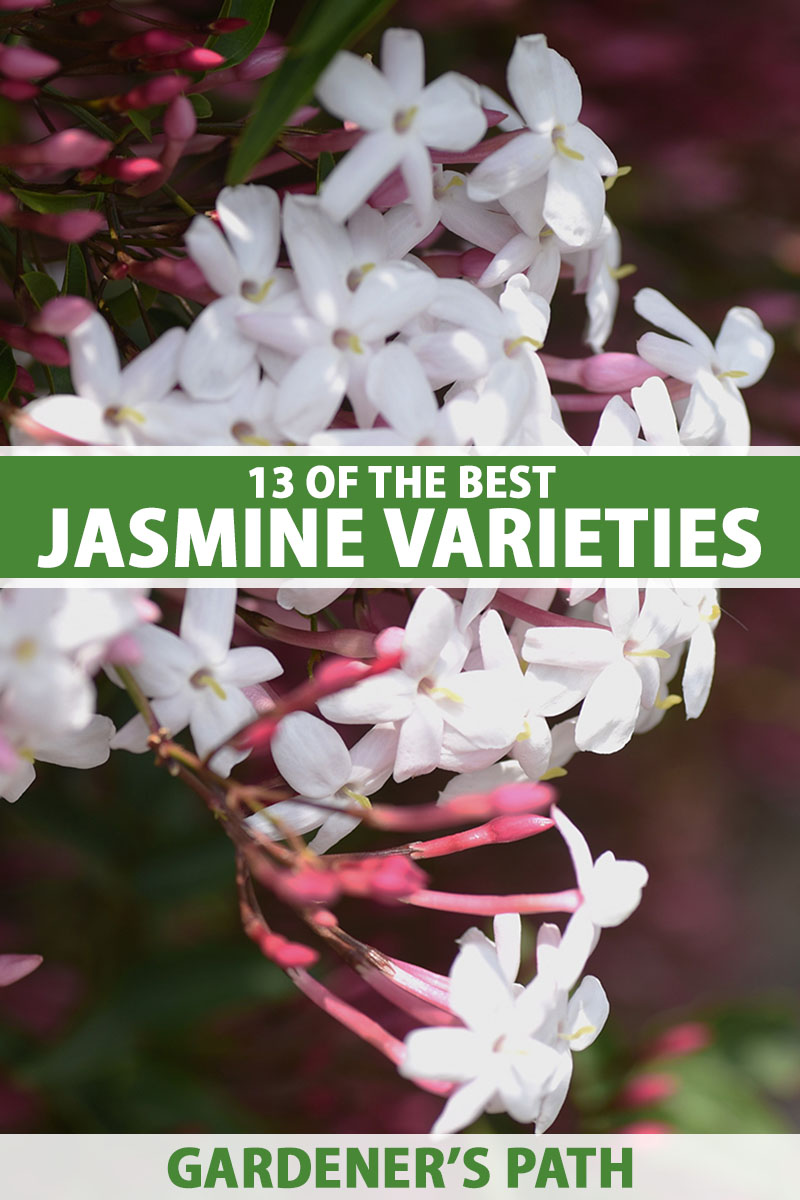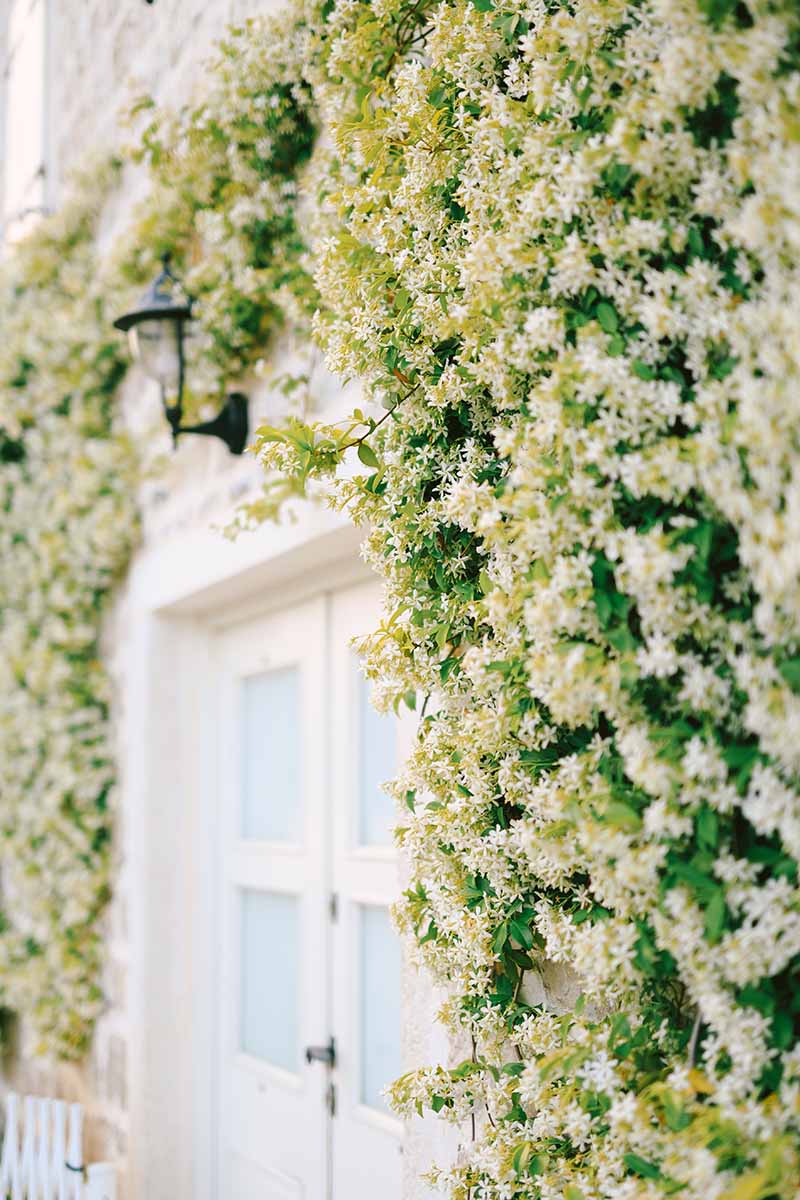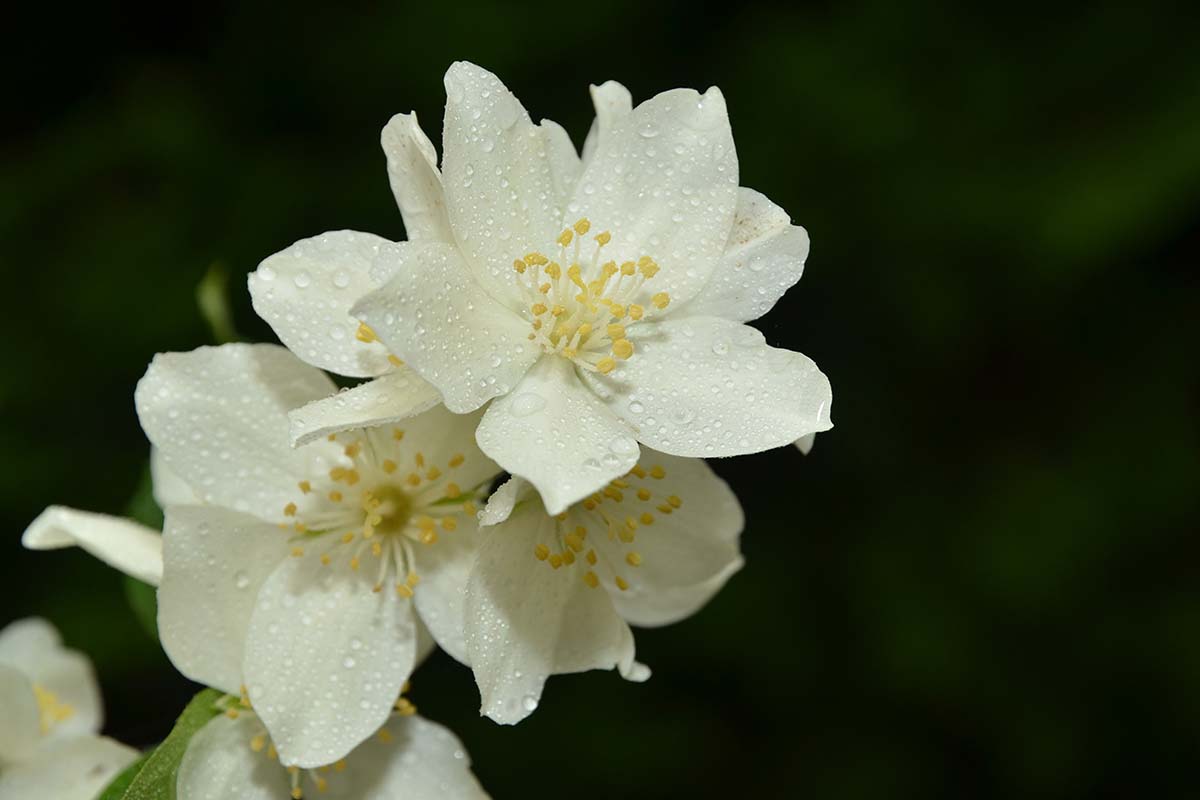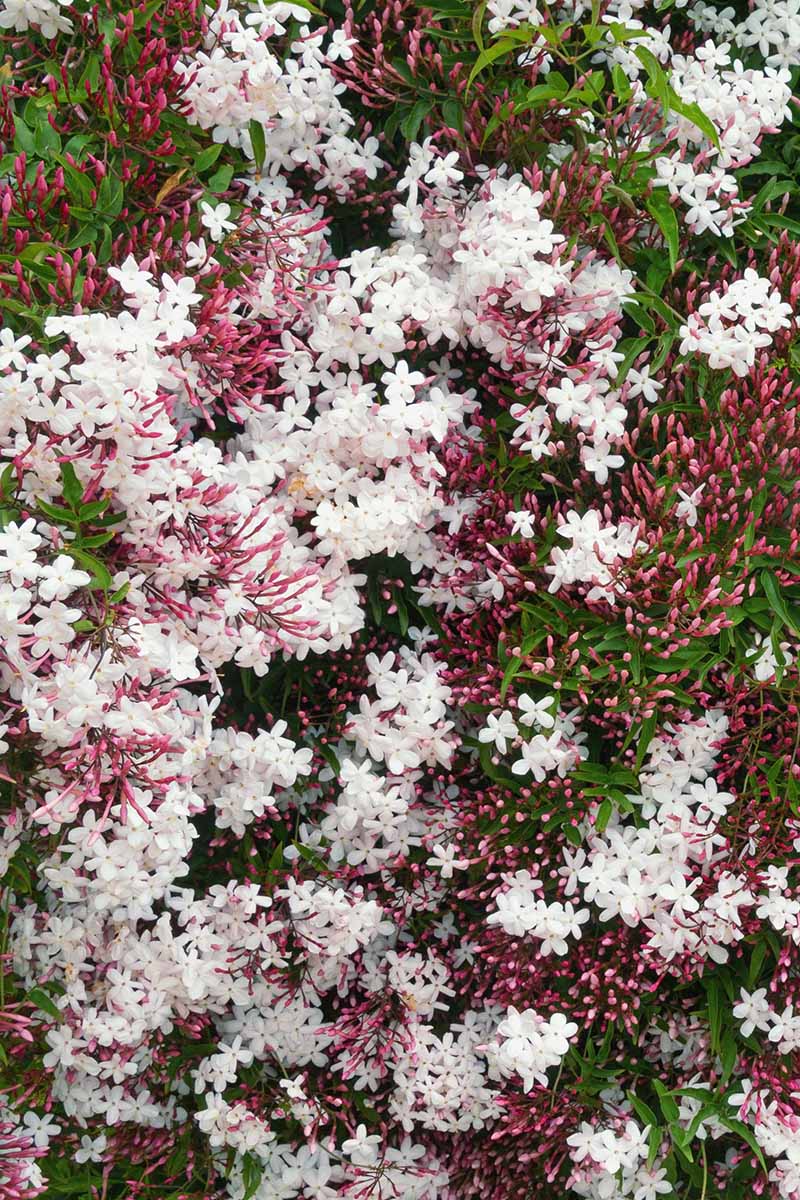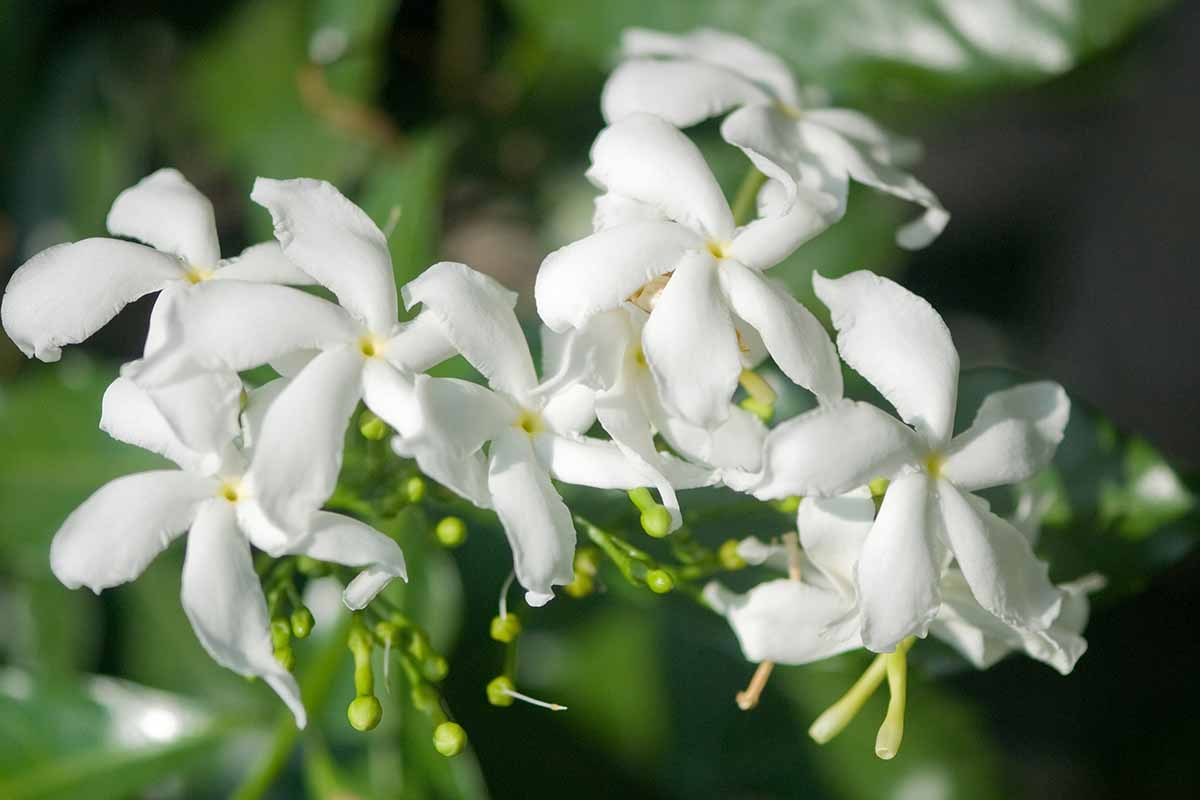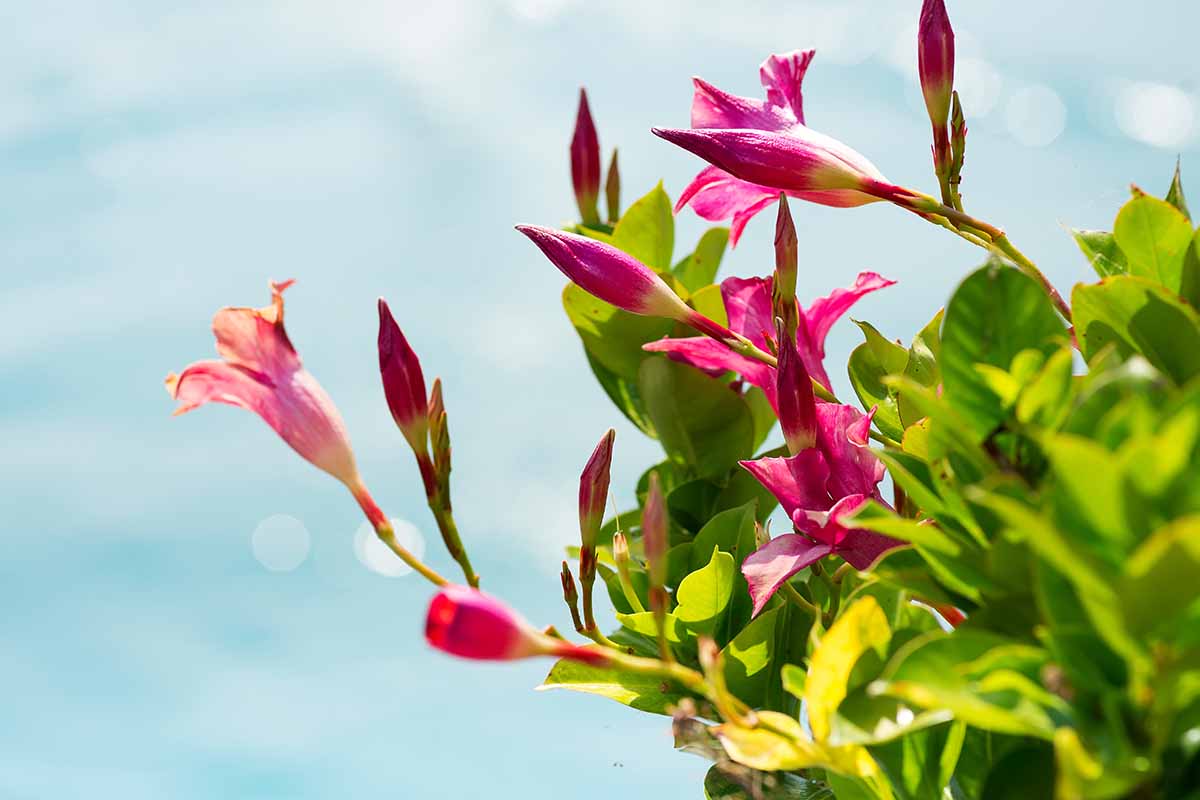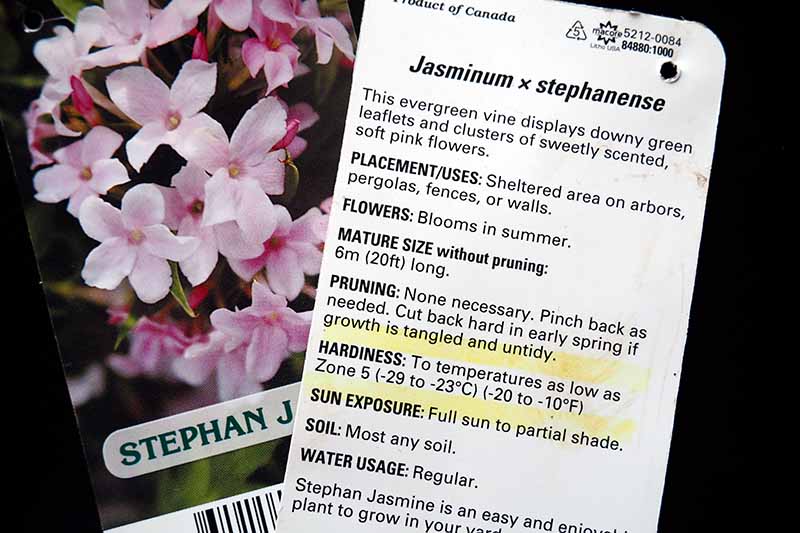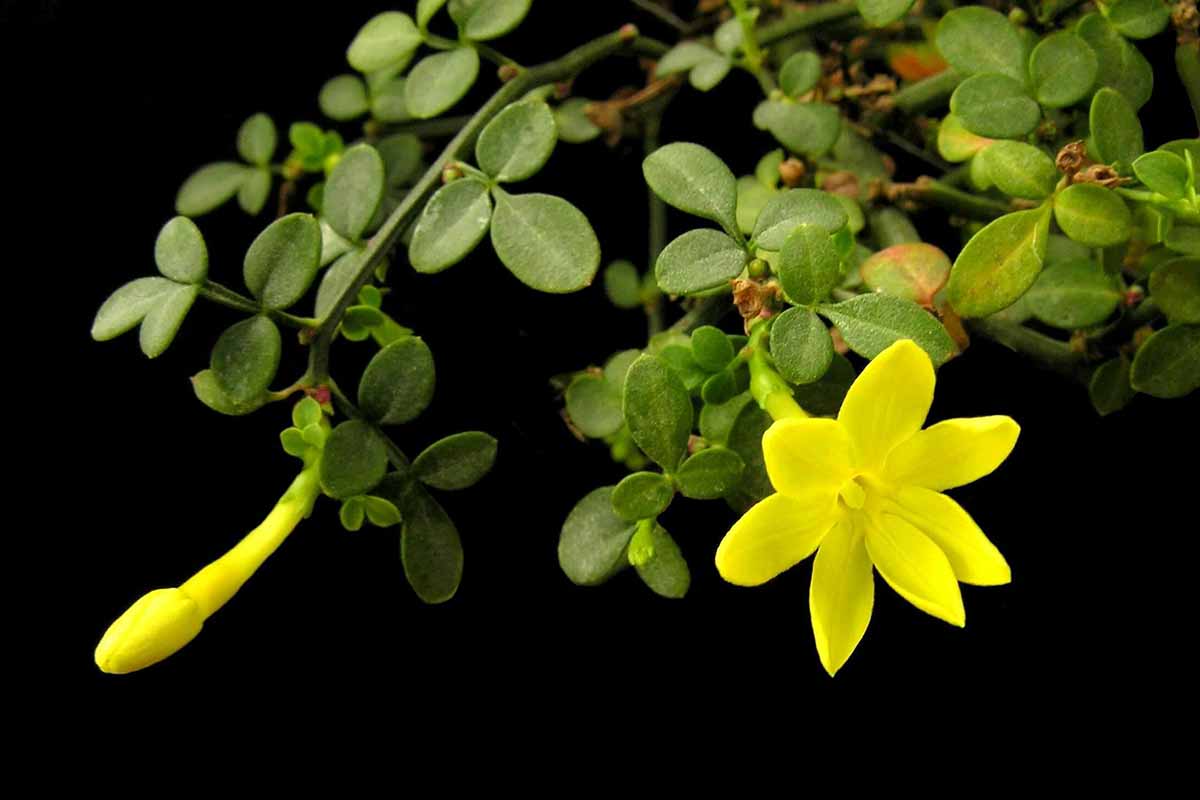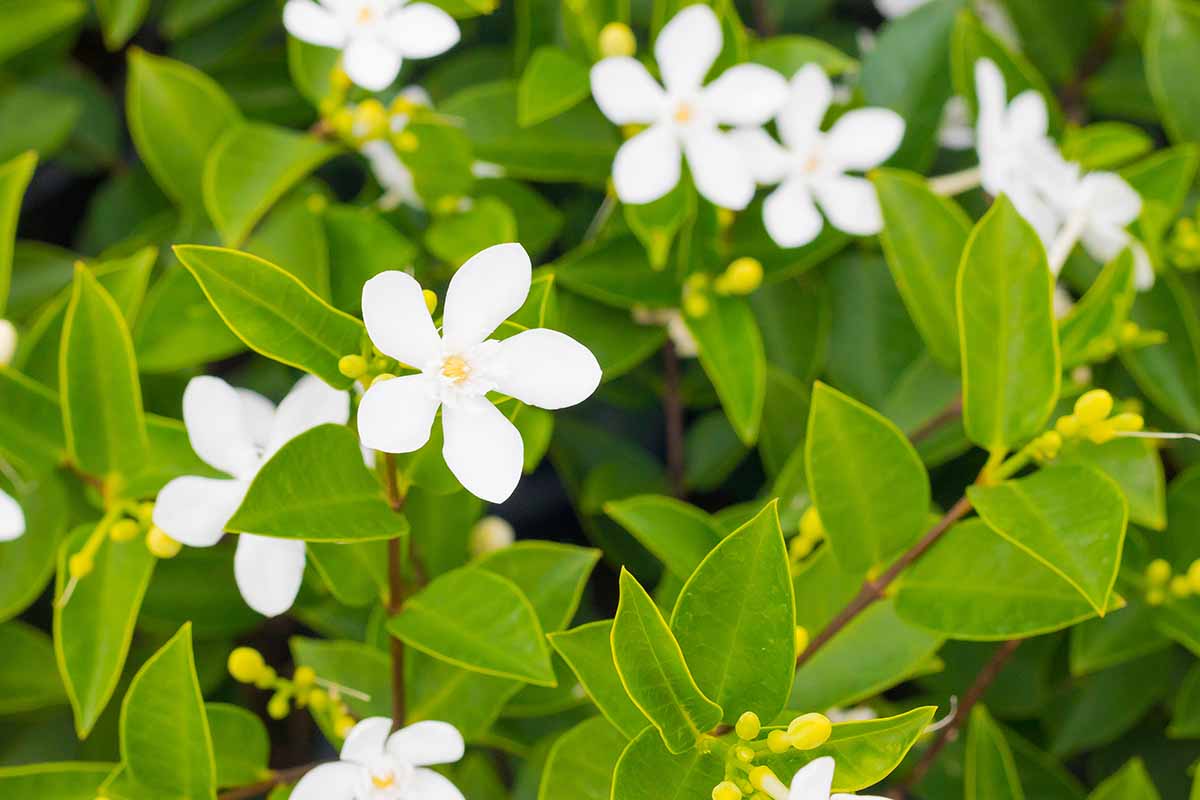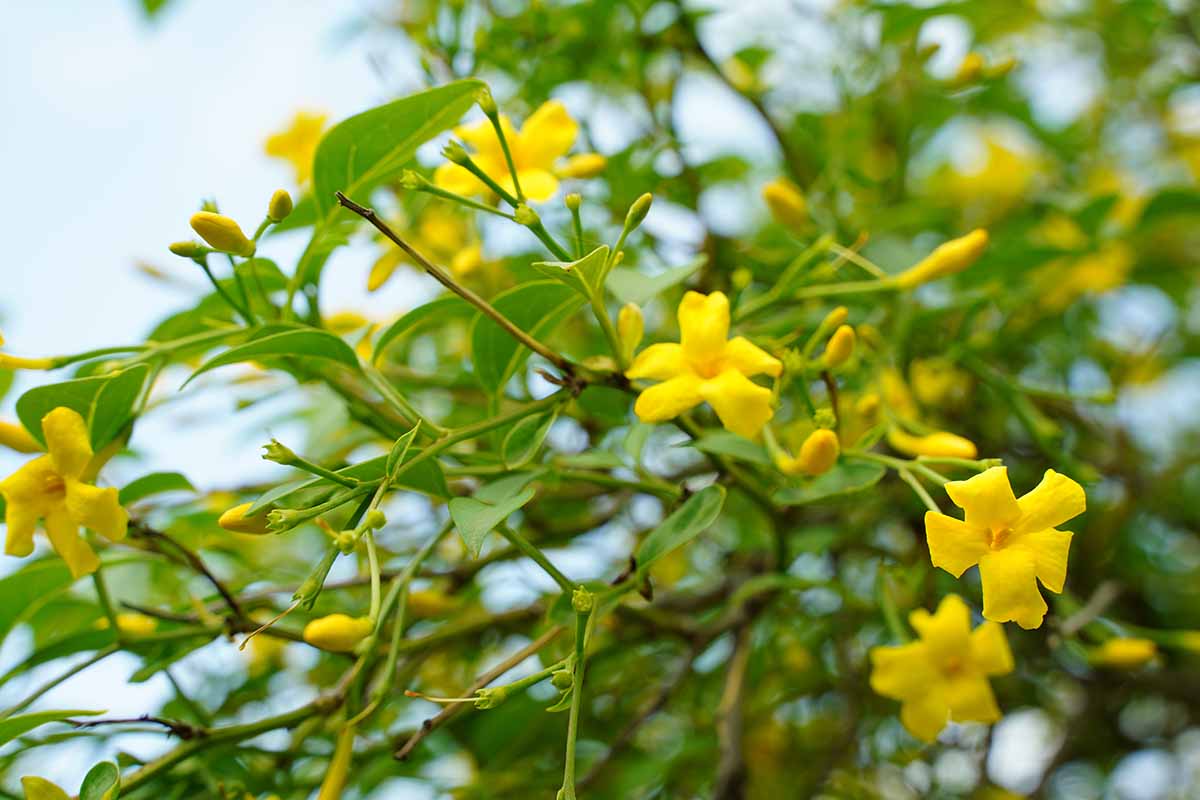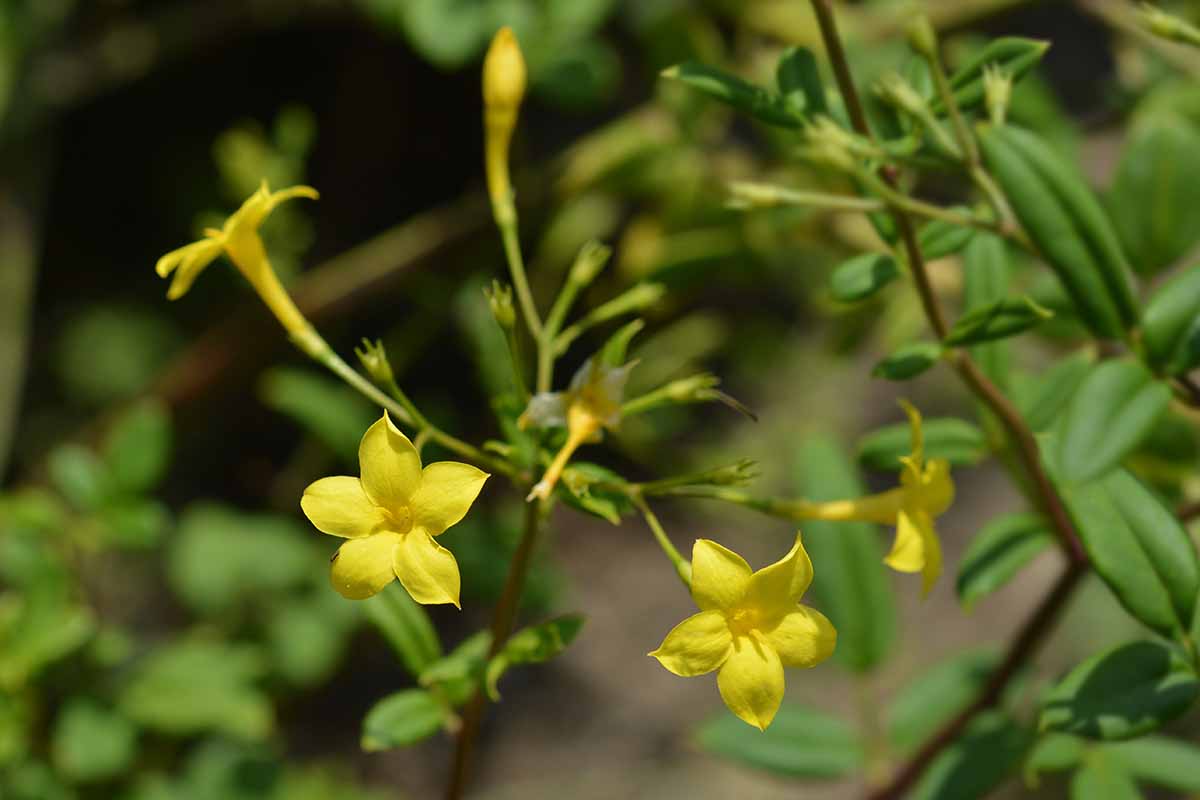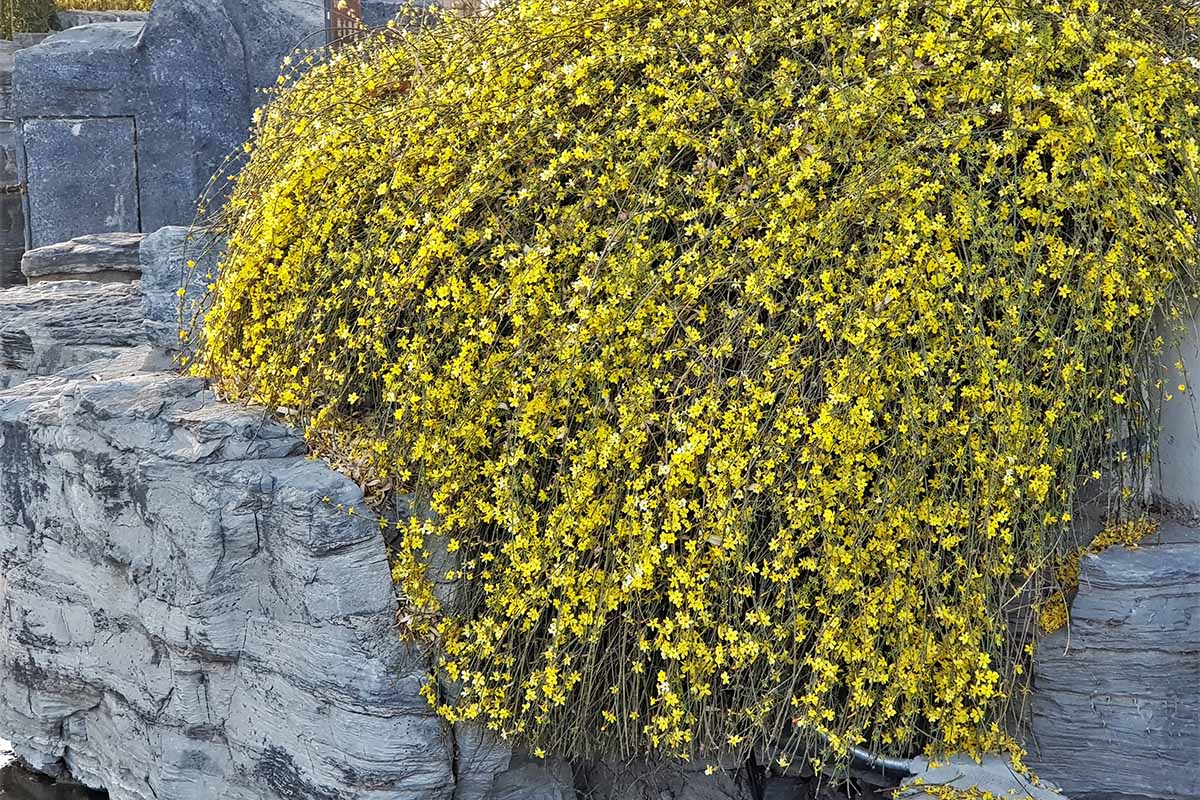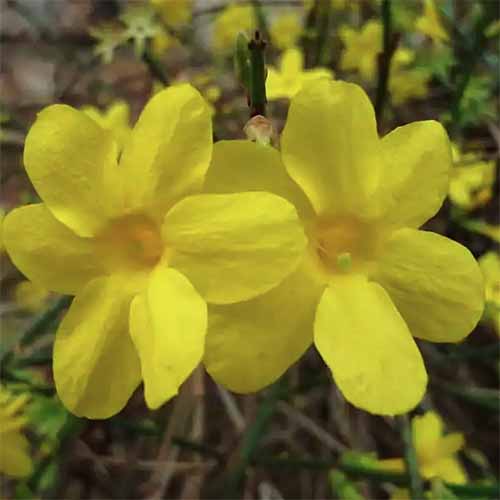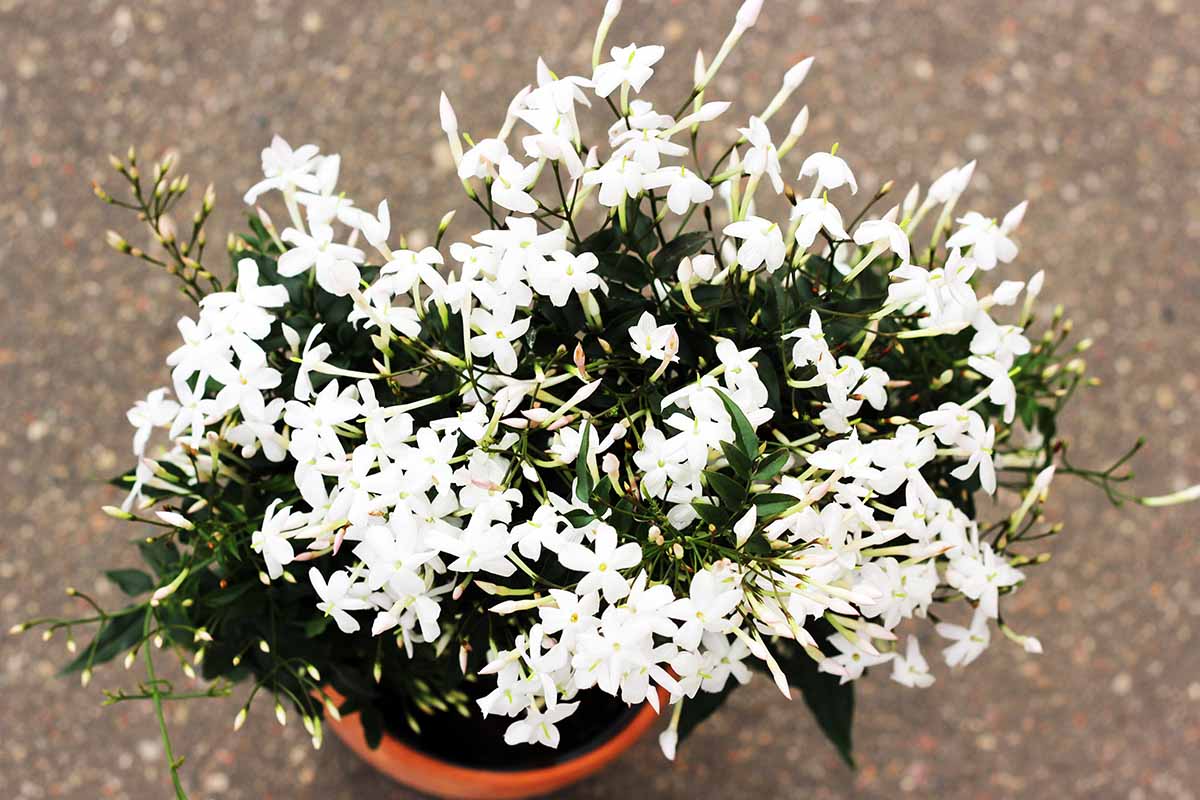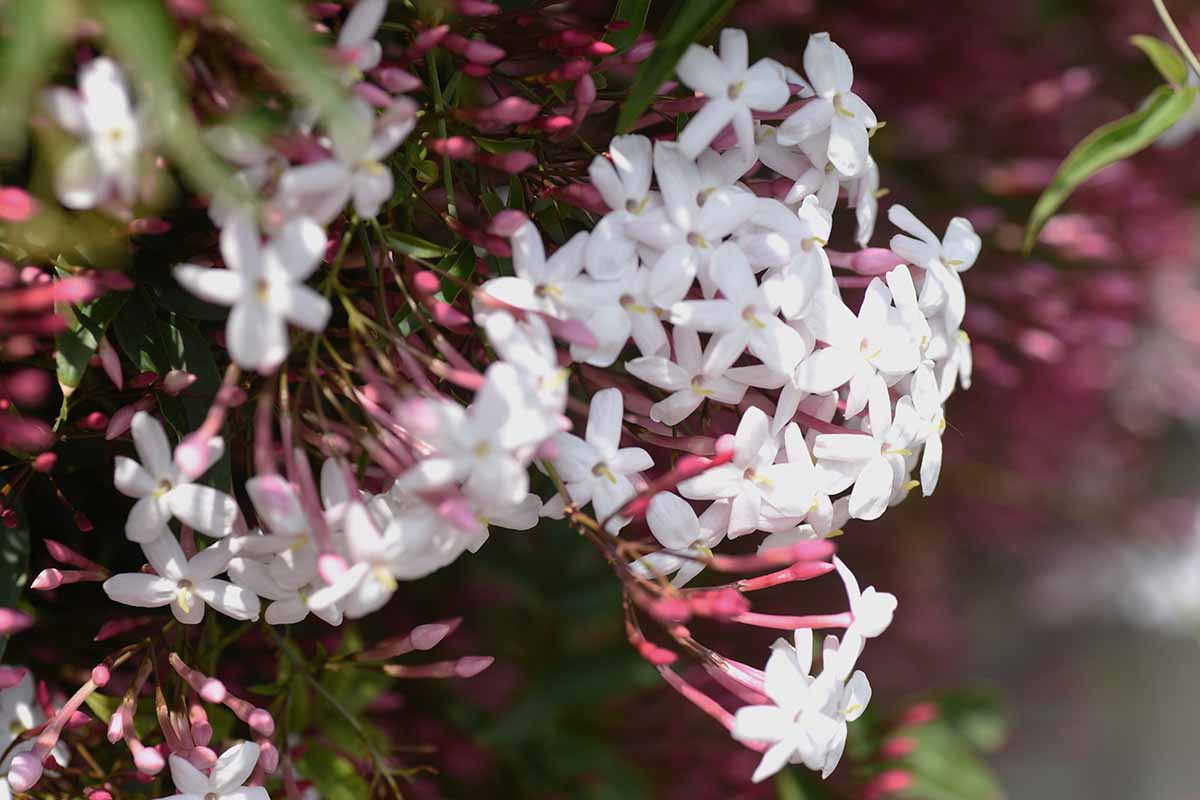Many of us are familiar with the tall vining types. These are the beautiful climbers, twining around supports and structures, adding pretty perfumed flowers to arbors, pergolas, porches, screens, and trellises. But there are also equally delightful shrub varieties. Typically smaller in stature, they have stiffer stems that can be trained onto upright structures or espaliered along fences and walls. We link to vendors to help you find relevant products. If you buy from one of our links, we may earn a commission. And some of the shrubs also make an effective ground cover or slope stabilizer. The long stems root readily where they touch the ground and form impressive, dense barriers and hedges. Most species are summer flowering, but there are also winter-flowering ones that provide an early food source for pollinators. And it should also be noted that not all jasmine plants are fragrant. If perfume, or a lack of it, is important for you, check the plant specs carefully to avoid disappointment. Tender perennials, most are hardy in USDA Hardiness Zones 8 to 11, with a few suitable for cooler regions. But don’t despair if you’re outside their climate range. Many varieties are well-suited to container growth and make excellent year-round houseplants or indoor winter guests! To learn more about how to care for these plants, check our guide on how to plant and grow jasmine. Now, let’s have a look at 13 popular types of jasmine vines and shrubs for your home and garden. Here’s what we’re looking at:
Vining Types
For climbing vertical displays, vining types require a trellis or other upright structures to support them. The thin, willowy stems are twiners – they don’t have tendrils or suckers but climb by tightly wrapping shoots around a support in an upward spiral. Provide a trellis when planting and gently wrap stems around a slat or post, or attach them with plant clips, twine, or garden velcro to get them started. Once in place, the tender stem tips seek out and wrap around supports on their own. Tuck in stray stems over the growing season and prune after flowering to tidy plants. Here are some popular twining types:
1. Azorean
Native to the Portuguese island of Madeira, Azorean or lemon-scented jasmine (J. azoricum) is an evergreen vine prized for its sweet, lemony fragrance and beautiful, pure white flowers. Clusters of pink buds open to delicate, star-shaped flowers that bloom from late spring into autumn on plants that grow 10 to 12 feet. A beautiful climber for arbors, screens, and trellises, J. azoricum is a Royal Horticultural Society (RHS) winner of the Award of Garden Merit (AGM). Hardy in Zones 10 to 12, the lemon-scented variety also makes an excellent indoor or glasshouse specimen.
2. Forest
The forest species (J. abyssinicum) has a natural range from central to south Africa, an evergreen climber that grows in high-altitude forest canopies. Vines are well-suited for partial shade and feature glossy, dark green leaves with panicles of pink buds that give way to sweetly fragrant white flowers that bloom in midsummer to fall. The fast-growing stems reach a height of 16 to 18 feet and require a sturdy arbor or trellis to climb on. These handsome vines also make an attractive, scrambling coverup or dense screen. Hardy in Zones 8 to 11.
3. Pink
Native to forested valleys of southwest China, the highly floriferous pink species (J. polyanthum) is simply delightful with masses of burgundy pink buds that open to intensely fragrant, pink or white star-shaped flowers. A spectacular deciduous to semi-evergreen climber, vines are first adorned with clusters of raspberry pink buds, then highly fragrant, star-shaped white flowers throughout summer. An AGM winner, J. polyanthum is highly popular as a houseplant as well but requires vigorous pruning for indoor cultivation. Hardy in Zones 8 to 11. Pink Jasmine Gardeners in California can purchase plants in one-, five-, or 15 gallon pots from Plants Express.
4. Poet’s
One of the most popular species, poet’s or true jasmine (J. officinale) is indigenous to the slopes of the Caucasus and Hindu Kush mountains of central Asia. Three cultivars are AGM winners: ‘Argenteovariegatum,’ Fiona Sunrise (aka ‘Frojas’), and ‘Inverleith.’ The fast-growing plants reach 15 to 40 feet and are most impressive clambering up and over arbors, pergolas, porches, and trellises. This species can also make a good houseplant with attentive pruning. Hardy in Zones 8 to 11.
5. Spanish
Spanish or Catalan jasmine (J. grandiflorum) is a deciduous to semi-evergreen climbing vine native to northeast Africa, the Arabian Peninsula, and south Asia. Scandent, or twining, stems have glossy, dark green leaves, pink-tinged buds, and fragrant white flowers – among the largest of all species – that bloom from midsummer to fall. Another AGM winner, it makes a superb climber for arbors, trellises, and screens, or intertwined with climbing roses. This species does well in containers around decks, patios, and seating areas, and it’s also a good choice for indoor cultivation. The vines grow eight to 12 feet and these plants are hardy in Zones 10 to 12.
6. Stephan
A dense, twining vine loaded with masses of fragrant pink flowers in summer, Stephan jasmine (J. × stephanense) is a naturally occurring interspecific hybrid of J. beesianum and J. officinale. Indigenous to high-altitude forests of southwest China, it’s among the hardiest of all varieties with fast-growing, evergreen vines that reach a mature height of 20 feet. A beautiful climber for arbors, pergolas, porches, and trellises, there is some dispute regarding its hardiness, with most nurseries listing it in the range of Zones 7 to 10. However, there are many anecdotal stories of these plants surviving and thriving in Zones 5 and 6. And while this may be due to acclimation in protected sites, I’ve just bought a couple of Stephan plants with a Zone 5 rating on the garden tag. If you do decide to cultivate them in colder regions, I suggest taking a few cuttings after flowering and overwintering them in a frost-free area… just in case!
Shrub Types
Shrub species of jasmine are typically smaller in overall size with a loose, scrambling, or sprawling growth habit. The stems are stiffer than those of vining types and don’t typically entwine, although many clamber and scramble readily through loose supports like wire fences. They’re also easy to train or espalier along fences, trellises, and walls, and can be pruned into a standard shrub shape. The arching or shooting stems frequently self-root where they touch the ground, forming dense thickets that make excellent spillers over retaining walls, ground covers, or slope stabilizers. To maintain a tidy shape and manageable size, prune after flowering and trim lightly over the growing season.
7. Angel Wing
A beautiful shrub, angel wing jasmine (J. nitidum) is native to the Admiralty Islands of Papua New Guinea. A fragrant evergreen, it has unique, long-petaled white flowers with a purple tinge. Blooming in summer, the white to pale pink single flowers are simple and star-shaped while double blooms have wide, overlapping flowers similar to camellias. These plants reach a height of up to 15 feet and are hardy in Zones 10 to 11. Angel Wing Plants Express carries angel wing jasmine in one- or five-gallon containers available for shipping to California residents.
8. Arabian
An evergreen shrub, the Arabian species (J. sambac) is indigenous to southeast Asia and the Indian subcontinent and is favored for its small, waxy, white flowers with an intense vanilla fragrance. An AGM winter, use a trellis for semi-twining growth or leave unsupported as a sprawling shrub for barriers, containers, and foundations. This species can also be pruned into a standard shape as a specimen and makes an attractive houseplant. Plants reach a height of up to 12 feet and are hardy in Zones 9 to 11.
9. Dwarf
An evergreen native to northern India, dwarf jasmine (J. parkeri) is an adorable, mounding shrub with arching stems covered in small, fragrant yellow flowers in the early summer garden. Plants reach a mature height and spread of two to three feet and feature nicely as low-growing barriers, borders, and hedges, cascading from containers, or in rock gardens. This species also makes an attractive addition to bouquets and floral arrangements, and it’s hardy in Zones 9 to 10.
10. Indian
A small climbing shrub, Indian jasmine (J. auriculatum) is native to the Indian subcontinent and commercially cultivated in India and Thailand for its fragrant essential oils. Bunches of white, starry flowers with a deep gardenia scent bloom in late summer and into fall on plants that grow four to five feet. A lovely, evergreen ornamental for barriers, containers, foundations, and hedges, plants are hardy in Zones 9 to 11.
11. Italian
Italian or yellow jasmine (J. humile) is an evergreen shrub native to Iran and central China that has naturalized in southern Europe. Clusters of fragrant yellow tubular flowers bloom in late spring and continue to early fall. If left unpruned, plants will reach up to seven feet tall and wide. ‘Revolutum’ is a popular cultivar that received the RHS Award of Garden Merit in 1993. Plants are hardy in Zones 7 to 9.
12. Showy
Showy jasmine (J. floridum) blooms from early summer to fall with bright yellow lightly fragrant flowers. Native to China, this evergreen shrub is ideal for foundation plantings, pruning as specimens, or allowed to cascade over unsightly walls. Hardy in Zones 8 to 10, plants can reach up to five feet tall and four feet wide.
13. Winter
Winter jasmine (J. nudiflorum) is indigenous to central and western China. It’s a non-fragrant deciduous shrub that produces bright yellow, star-shaped flowers on bare branches. An AGM winner, plants flower in late winter and early spring. With a mature length of up to 15 feet they’re among the best for gardeners with cooler winters, with a hardiness suitable for Zones 6 to 9. Winter Jasmine You can find plants available in two-quart containers from Home Depot. Learn more about growing winter jasmine in our guide.
A Note on Indoor Plants
Both shrub and vining types of jasmine can be used for indoor cultivation. Those most often used as houseplants include the vining pink (J. polyanthum) and Spanish (J. grandiflorum) species, as well as the shrubby Arabian (J. sambac) species. All those grown indoors need to be pruned to maintain a compact habit, and the vining varieties require a hoop or trellis as well.
Fragrant Finery
Long, twining vines or sprawling shrubs, jasmine is delightful in the garden, grown in containers, or enjoyed as houseplants. If you’re looking for dramatic, perfumed vertical displays, choose the long, lanky vines. For dense barriers, ground covers, or specimens, shrub types are the better choice. And for indoor cultivation, choose container-friendly types that can be standardized or pruned into manageable sizes. Whichever type you choose, be sure to place some under windows and around patios or seating areas to fully enjoy their magnificent, fragrant finery! But remember, not all varieties are fragrant, so check individual details to get the best ones for your garden. Are you growing jasmine? Do you have a favorite? Let us know in the comments section below, and feel free to share a picture! And for more jasmine know-how, add these guides to your reading list next:
How to Prepare Jasmine Plants for Cold WeatherHow to Grow Asiatic Jasmine
